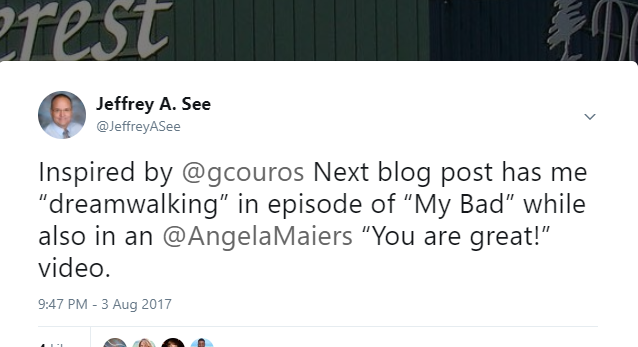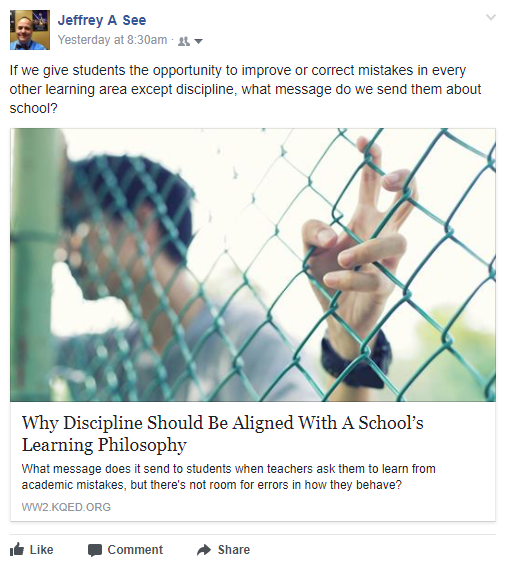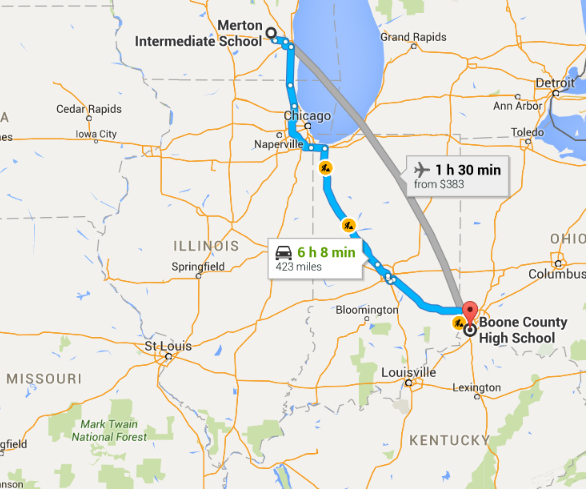Let me warn first that you can probably categorize today’s post under “Longform” – minus the journalism. So I warned you – this is long. If you choose to read it on, I think it is worth the time.
Yesterday, on my ride home from work (I have an hour-long commute from Clintonville to Oshkosh), I reflected on the strife we have seen since Tuesday night. I worked this week to help keep those most vulnerable in my school safe, and it led to a lot of reflection. I thought about the highlight from my week: reading to a young man who in spite of his uncontrollable fits of rage (or maybe because of them) has me rooting for him. When I came home last night, I made a decision and sent out a post to my friends and family on Facebook.
The response was incredible. I have so many titles recommended that I cannot wait to talk about with this child on Monday. Some very kind folks are also sending some books or means to get some books for this student. My sister even reminded me that I have some ancient action figures that might make this boy smile. Thanks, Wendy!
As part of my Facebook post, I promised to tell everyone the entire story in a post on my blog. I’m hoping if folks see this young man as I see this young man, more of them will choose to rally to his cause.
I first met “Sam” (not his real name, but having to say “this boy, child, young man” feels disconnected and artificial) last year when Scott and I went to the elementary school to meet and welcome our future students. Sam stood out immediately – he with his fists clenched, a sullen look, and inability to make eye contact – because he swung from rage to elation so quickly. He knew we were coming, so as soon as he saw us he came over to share the paper airplane he made. That was our first fist-bump.
This school year has been an understandable adjustment for Sam. New building. Bigger kids. New bullies. Earlier this year, Sam struggled greatly. When he became angry, he would put his jacket hood on his head, clench his fists, and “march” like Frankenstein’s monster down the hall, not hearing or seeing anyone who got in his way.
One time in particular, students in the cafeteria for breakfast made it difficult for Sam. The next morning, I ate breakfast in the cafeteria with Sam, reassuring him with a fist bump that “We got this.” I also started making up reasons to show up in his classes or bump into him in the hall. One morning for breakfast Sam looked at me asked, “Are you stalking me?” I laughed and said, “No. I missed our fist bump today. You were mad at something and left me hanging.” He grinned and said, “Not today. Tomorrow.”
Several weeks ago, one of Sam’s teachers came to me before school and said he felt Sam needed to talk to me about a consequence. He was sent to that room for help on reading but was refusing to read and had started swearing at the teacher about this. [Let me reassure everyone. This teacher is not naive; he has worked with emotionally and behaviorally disturbed students for decades, and understands when a student needs intervention beyond what he can offer in the classroom.] I told the teacher I would swing by his room after school started and have a talk with Sam.
When I came into the room, I saw Sam trying to concentrate on one of Gary Paulsen’s Hatchet Adventure Books. I asked him to come with me so we could chat. He got up right away and started to follow. Then he stopped, went back, and put something in his cubby hole in the back of the room. I asked him if he needed any of that for his next class, but he said his teacher just had him keep that stuff in the classroom, so he wouldn’t lose it.
As we made our way to my office, I asked Sam why he didn’t want to read chapter books. He replied, “I don’t like that I have to answer questions while I read.” We talked about how we don’t always have to answer questions. Next I asked him what kinds of books he liked to read at home. He said he didn’t. When I asked why, he said “We don’t have any books at home.” That stopped me short. Further questions helped me learn that he liked books with adventures and that he didn’t like chapter books in middle school because they didn’t have as many or sometimes any pictures compared to the books he liked reading.
Once at my office, we talked about how Sam might have handled the situation with his teacher differently next time. He had a lot of great ideas, and I learned that the will to read was there. We just hadn’t found the right books yet. As we neared the end of our chat, Sam said he needed a consequence for his actions because he didn’t handle it the right way. While it lifted my spirits that Sam knew he hadn’t handled his frustration well, I knew this was a blip. We had about ten minutes left in class, so I said that if it made him feel better he could sit in the ISS room until the bell rang but that he wasn’t being punished.
At that moment, he took time to look around my office. He said, “Hey…do you like Star Wars?” I asked why he asked, and he correctly noted that I had thirteen different Star Wars things in my office. I told him that I LOVE Star Wars, and he screamed, “Me, too!” I told him I was just about his age when the original Star Wars came out in the theater. He said, “Wow. You are old.” We fist-bumped, and Sam headed to the ISS room.
After a minute, I checked on Sam and told him he could just sit if he wanted, but I asked him to think about reading his book. He opened it, and I said, “Sam, don’t do it for me. If you feel like it, do it for you.” A minute later, Sam came into my office asking for a pencil and paper. I asked why he needed those, and clearly exasperated with my lack of knowledge, Sam sold me in his best “Duh!” voice, “Because he’s going to have questions for me about my book!” I smiled a lot after that.
That weekend, I ended up inside Barnes & Noble, looking for Star Wars chapter books with pictures. I found lots of great-looking titles and settled on Star Wars: Before the Awakening.
Thursday morning of this week, I went down to that same teacher’s room and asked Sam to come with me to my office. I think he thought he was in trouble, because he pulled the Frankenstein march on me. When we got to my office, I pulled out the book and showed it to him. Sam’s face lit up and he just had a look of awe. I explained that this told the stories of some of the characters in The Force Awakens before we meet them in the movie. I talked about Finn and Rey and Poe. And then a funny thing happened. Sam leaned in close and whispered, “Actually, Mr. See, I haven’t seen the new movie. I don’t know who those people are.”
At first, I stopped short. How had he not seen this movie? In the next breath, of course, I remembered that Sam is homeless and lives in a motel in town. No, he had not seen the movie. I said, “Sam, it’s OK that you haven’t seen the movie. Unlike most of us, you will know these characters before you see the movie. I bet you’ll enjoy it even more than I did.” He said, “My dad can’t afford that movie.” I simply reassured him that “We’ll figure out a way.” His reply cut right at my heart. “I didn’t think I’d ever get to see it.”
Sam started out reading, but struggled with some of the words. I helped him pronounce them, and we talked about what they meant. At one point he became so frustrated, that I said I could find an easier book, if he wanted. He looked at me and said, “Not a chance!” Like I have done since I read the Lemony Snicket and Harry Potter books to my own daughters, I created voices for all of the characters. As tension rises, so does my voice. When a whisper is called for, I use that, as well. I lean in on the action when I have to and cover my eyes when I don’t want to watch.
When it was Sam’s turn to read again, I pulled up short again and felt that pesky, salty discharge in my eyes. You see, Sam read and created voices for the characters, and even though it did not match the action of the story, he had tension or softness in his voice. I had not expected that.
As I read Finn’s story, which starts with a tense battle simulation, Sam literally squirmed around in his chair, squatting or moving from one knee to another as the battle action called for it. Together, we lowered our heads to the conference table in my office, spying for FN-2000 and FN-2099 and the enemy gun.
When I closed the book after the action-packed battle simulation opening, I told Sam that this is his book and that when we are done it is his to take home. His jaw dropped and he asked so questioningly, “Mine?” When I said yes, he whispered, “I’ve never owned my own book.” I want to remedy that problem, so that’s why I posted to Facebook.
I’m not so naive as to think I can “fix” poverty or even that I can save every one of our students in need. Instead, I’m hopeful that each time I have the opportunity, I can provide hope that ripples outward. The battles raging on social media right now are beyond my ability to repair. What I can do is make sure that a little boy who has never owned a book, gets some books to call his own. Maybe he will one day read to his own children. And maybe they will have hope.
I apologize for the lengthy post. I hope you felt this story that needed telling was worth your time.




